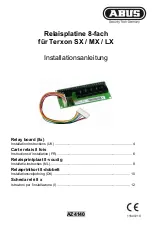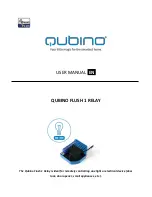
7SG16 Ohmega 402 60 Protection Schemes
©2010 Siemens Protection Devices Limited
Chapter 3 Page 11 of 13
It should be noted that when the remote end trips, the CB open condition will drive this relay into a CB Echo
condition also due to the Signal Receive being present. This is the reason that the Echo is sent as a short
duration pulse only. Otherwise the relays will hold each other in a permanent echo condition.
2.3.3 Current Reversal Guard.
Additional logic is required in cases where the reach of Zone 2 elements is set to 150% or more of the line length
and a fault has a current source at both ends of the protected line. Where parallel feeders are used, there is a
danger that when a circuit breaker is opened a race condition can arise between the drop-off of the signal send
line and the pick-up of the local distance elements. Consider a fault at point F on the parallel line system shown
below:
Point F is within the Zone 2 forward reach of relay D, so relay D will send a permissive signal to the remote end,
relay C. Relay A will detect the fault in Zone 1, and trip instantaneously.
The instantaneous Zone 2 element of Relay A will operate, and send a signal to Relay B. Relay B will see the
fault in Zone 2, and when it receives the signal from end A will perform a “Carrier Aided Trip” after a short time
delay. Thus, Relay A will trip before Relay B, and when it does, direction of current in the healthy feeder (CD) will
reverse.
The Relay D Zone 2 element, which previously operated to send a signal to Relay C will reset when breaker A
opens. But the signal receive may remain high at end C due to the propagation delay in the signalling channel.
The Zone 2 element of relay C will then pick-up for the fault at F when CB A opens. There is then a race
condition at relay C between the drop off of the signal receive from Relay D and the pick-up of Relay C Zone 2
element. IF the signal receive element is still present in conjunction with the Zone 2 element, then Relay C will
also carry out a “Carrier Aided Trip”, for a fault outside it’s intended zone of protection.
Thus, if the local Circuit Breaker is closed, and a relay has received a permissive signal, but the fault is in the
reverse direction, there’s a danger of a current reversal trip when current reverses. Thus, a ttime delay,
POR
Current Rev Reset
is introduced for which the permissive signal from relay C will be ignored by the carrier aided
scheme following the resetting of a reverse fault detection.
2.3.4 Weak End Infeed.
If one end of the line has little or no source of fault current, the relay may not see enough fault current to cause a
trip or accelerate the tripping at the remote end. Weak Infeed logic is used to detect this condition. Weak Infeed
can be Enabled and Disabled to switch on the Alarm and the scheme signalling and an independent
enable/disable setting is used to allow the issue of a local trip for a Weak Infeed detection. If the relay has not
detected a fault in either the forward or reverse direction, and a permissive signal is received from the remote
end, AND there is a residual voltage greater than the WI Voltage Level AND the local CB is closed, the relay will
Relay
D
Relay
C
S/Stn 1
S/Stn 2
Relay
B
Relay
A
F
I
I
I
I
Relay
D
Relay
C
S/Stn 1
S/Stn 2
Relay
B
Relay
A
F
I
I
I
I
I
















































